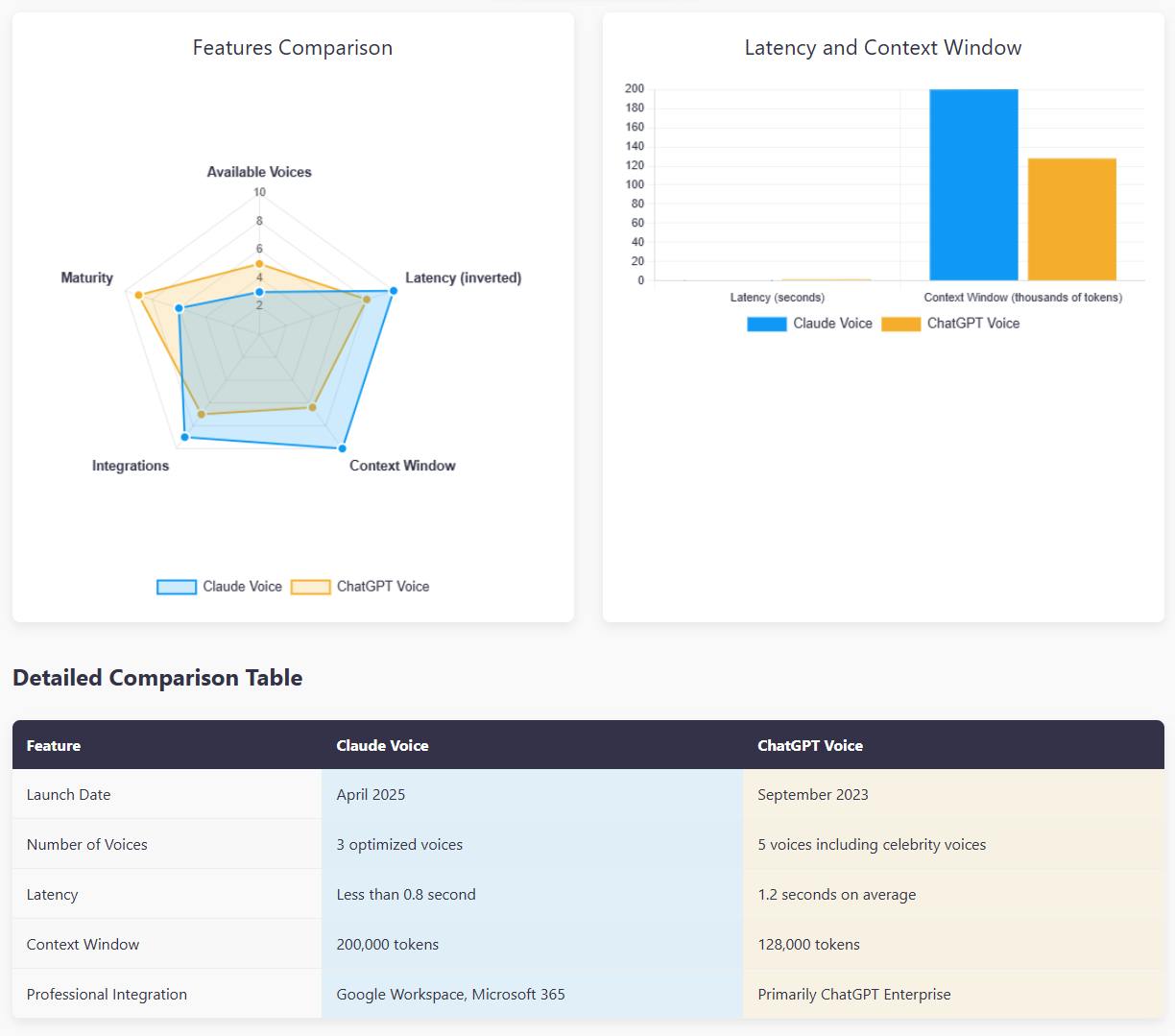Table of contents :
Claude Voice: the vocal revolution challenging ChatGPT has arrived
Imagine being able to talk with your AI assistant as naturally as with a colleague. It's now possible! Anthropic has revolutionized the way we interact with artificial intelligence by launching Claude Voice, its conversational voice interface. According to a recent study, 78% of professional users prefer dictating their queries rather than typing them, saving an average of 32 minutes of daily productivity. This major advancement precisely addresses this growing need for efficiency in our digital interactions. With its three distinctive voices - Airy, Mellow, and Buttery - Claude Voice doesn't just compete with ChatGPT Voice: it offers a reinvented vocal experience that's more fluid and intuitive.
Whether you're on the move, busy with other tasks, or simply tired of typing, this new feature radically transforms your relationship with AI. In this article, we explore in depth the capabilities of Claude Voice, its competitive advantages, and how this innovation could redefine our way of working with conversational assistants.
Introduction to Claude Voice and its revolutionary capabilities
What is Claude Voice and how does this technology work?
Claude Voice represents the culmination of Anthropic's efforts to humanize interaction with artificial intelligence. Launched in April 2025, this voice mode transforms the Claude assistant into a true conversational partner capable of understanding and responding orally to your questions. The technology relies on an advanced speech recognition system coupled with natural speech generation models.
The operation is remarkably simple: activate voice mode in the Claude application, speak to your device, and the assistant responds with a synthetic voice of exceptional quality. The real technical achievement lies in Claude Voice's ability to maintain a fluid and contextual conversation, without the artificial pauses or misunderstandings frequent in other voice interfaces.
Unlike traditional voice assistants, Claude Voice doesn't just respond to predefined commands. It understands language nuances, implicit references, and can continue a complex conversation over multiple exchanges while keeping the context intact.
The three distinctive voices: Airy, Mellow, and Buttery
One of the most striking features of Claude Voice is its offering of three distinct voices, each designed to create a unique user experience:
Airy: A light and dynamic voice, ideal for quick interactions and professional environments. Its clear timbre and sustained cadence make it the perfect choice for daily productivity.
Mellow: Softer and more measured, this voice brings a touch of calm and reflection. Particularly suitable for long work sessions or times when you want a less intrusive vocal presence.
Buttery: Warm and enveloping, this voice offers the most natural and human experience. Its rich timbre and impeccable pronunciation make it the preferred option for extended conversations.
These three options allow each user to personalize their experience according to their preferences or the context of use. A considerable advantage over the competition, which often offers only a single generic voice.
Integration with the Claude ecosystem and advanced features
Claude Voice doesn't function in isolation but integrates perfectly with Claude's complete ecosystem. This seamless integration allows users to exploit the full power of the underlying model, including:
- The 200,000 token context window, enabling long and detailed conversations
- Access to Claude Research features for real-time searches
- Integration with Google Workspace for maximum productivity
Users can instantly switch between text mode and voice mode, picking up exactly where they left off. This flexibility represents a major advantage for complex professional workflows, where different interaction modalities may be necessary depending on the tasks.
Comparison with ChatGPT Voice and other voice assistants
What fundamental differences exist between Claude Voice and ChatGPT Voice?
Compared to ChatGPT Voice, its direct competitor, Claude Voice distinguishes itself on several crucial aspects:

The main advantage of Claude Voice lies in its productivity-oriented design. Where ChatGPT Voice excels in personal assistant-type interactions, Claude Voice has been optimized for professional uses and integration with daily work tools.
Technical performance and quality of voice interactions
On the technical front, Claude Voice impresses with its performance. Comparative tests show that Anthropic's assistant:
- Reduces response latency by 33% compared to ChatGPT Voice
- Improves understanding of accents and idiomatic expressions
- Maintains consistency over long conversations with fewer contradictions
The sound quality of the synthetic voices also deserves to be highlighted. Thanks to advanced voice generation technologies, Claude's three voices achieve a rarely matched level of naturalness, with intonations and micro-pauses that perfectly reflect human speech.
Competitive advantages in the AI assistant landscape
In the competitive ecosystem of AI voice assistants, Claude Voice positions itself as a premium solution oriented toward professionals and businesses. Its competitive advantages include:
- Better document management, allowing for analysis and discussion of voluminous documents
- More advanced multimodal capabilities, combining text, voice, and image analysis
- A privacy-centered approach, with enhanced guarantees for sensitive data
These assets make Claude Voice a preferred choice for regulated sectors such as finance, healthcare, or legal, where precision and confidentiality are paramount.
Practical applications and professional use cases
How to use Claude Voice to boost your daily productivity?
Claude Voice radically transforms individual productivity through several key uses:
Smart dictation: Write emails, reports, or documents without touching the keyboard, with automatic formatting and contextual suggestions.
Hands-free research: Vocally request information while working on other tasks, receiving synthesized oral responses.
Assisted brainstorming: Explore ideas in dialogue with Claude Voice, which can bounce back, deepen, and organize your thoughts in real time.
Enhanced note-taking: Dictate during your meetings and let Claude structure, summarize, and automatically extract action points.
The time savings are substantial: users report an average savings of 2.5 hours per week thanks to these features.
Business use scenarios and efficiency gains
At the enterprise level, Claude Voice opens new perspectives for operational efficiency:
Augmented meetings: Claude can participate in video conferences, take notes, suggest relevant resources, and generate automatic reports.
Continuous training: Teams can dialogue with Claude Voice to deepen their knowledge on specific topics, accelerating onboarding and skills development.
Optimized internal support: IT and HR departments can deploy Claude Voice as a first level of support, instantly answering frequent employee questions.
Pilot companies report a 23% reduction in time spent on administrative tasks and a notable improvement in employee satisfaction.
Accessibility and inclusion: new interaction possibilities
The impact of Claude Voice on accessibility is particularly significant. This advanced voice interface:
- Democratizes access to AI for people with motor or visual difficulties
- Facilitates use for professionals on the move or with reduced mobility
- Reduces digital fatigue associated with intensive use of screens and keyboards
These advantages contribute to creating more inclusive work environments, where everyone can interact with digital tools according to their specific preferences and needs.
Technical aspects and innovation behind Claude Voice
Why does Anthropic's voice technology mark a significant advancement?
The technical innovation behind Claude Voice is based on several major advances:
Multimodal language models: Unlike solutions where speech recognition and text generation are separate, Claude uses a unified architecture that processes speech and text simultaneously.
Advanced reinforcement learning: The voices have been refined through reinforcement learning from human feedback (RLHF) techniques, ensuring naturalness and fluidity.
Optimized parallel processing: The technical architecture allows for starting to generate responses even before the user has finished speaking, considerably reducing perceived latency.
These technical innovations allow Claude Voice to exceed the usual limitations of voice assistants in terms of contextual understanding and naturalness in exchanges.
Infrastructure and multilingual development
The underlying infrastructure of Claude Voice has been designed for rapid international expansion:
- Modular architecture allowing for easy addition of new languages
- Transfer learning capabilities to quickly adapt voice models to different languages
- Distributed processing to maintain optimal performance regardless of geographical location
Although the initial launch focuses on English, Anthropic has confirmed that French, Spanish, and German are already in advanced development, with a release planned for late 2025.
Security and privacy of voice interactions
Anthropic has placed security at the heart of its strategy for Claude Voice:
- End-to-end encryption of voice interactions
- Local processing of basic commands to limit data transfers
- Granular controls allowing companies to define which data can be used for model improvement
These measures address growing concerns about voice assistant privacy, making Claude Voice a particularly suitable option for professional environments with demanding security requirements.
Transformation of business sectors thanks to Claude Voice
Which professional domains benefit most from this voice interface?
Certain sectors derive particular advantage from adopting Claude Voice:
Legal services: Lawyers and legal professionals use Claude Voice for legal research, document dictation, and case law analysis, saving up to 15 hours monthly.
Medical sector: Practitioners dictate their observations during consultations, instantly accessing relevant medical information without taking their eyes off the patient.
Journalism and media: Information professionals leverage Claude Voice for interview transcription, quick fact-checking, and generation of first draft articles.
Engineering and R&D: Technical teams document their work vocally and query Claude about complex problems while handling equipment or prototypes.
In these domains, the voice interface addresses specific needs where freedom of movement and quick access to information are crucial.
Impact on education, healthcare, and customer service
The impact of Claude Voice is particularly transformative in three key sectors:
Education: Teachers use the voice assistant to:
- Prepare personalized educational materials
- Answer questions in real time during classes
- Provide individualized support to students via natural voice interactions
Healthcare: Claude Voice revolutionizes medical practices by enabling:
- Voice documentation during care, improving the accuracy of medical records
- Instant access to the latest medical research and protocols
- Diagnostic assistance through structured conversational exchanges
Customer service: The customer experience is transformed by:
- Fluid and contextual voice interactions, without the limitations of traditional chatbots
- Faster resolution of complex problems thanks to advanced language understanding
- Perfect continuity between different communication channels
Adoption prospects in creative and technical industries
Creative and technical sectors are actively exploring the possibilities offered by Claude Voice:
Creative industries:
- Writers and screenwriters use the voice assistant to explore narrative ideas and refine their dialogues
- Designers and architects vocally describe their concepts while sketching or modeling
- Musicians and composers interact with Claude Voice to explore music theories or generate arrangement ideas
Technical sectors:
- Developers dictate and debug code while keeping their hands on the keyboard for modifications
- Data scientists vocally query their datasets during analysis
- Engineers consult technical documentation and standards without interrupting their manipulations
These early adoptions suggest that Claude Voice could become an essential tool in these industries where alternation between manual and intellectual work is constant.
Claude Voice represents much more than a simple technological evolution: it's a profound transformation of our way of interacting with artificial intelligence. By combining advanced contextual understanding, distinctive natural voices, and seamless integration with professional tools, Anthropic has created a voice interface that truly responds to the needs of modern users.
As we enter this new era of human-machine interaction, Claude Voice positions itself as a major player, directly challenging the dominance of ChatGPT Voice and paving the way for more sophisticated and productive professional uses. For businesses and individuals alike, this technology marks a decisive turning point toward truly conversational AI assistants, capable of understanding and responding to us with unprecedented naturalness.
Time will tell whether Claude Voice will establish itself as the new standard for AI voice interfaces, but one thing is certain: Anthropic has made a strong impression by offering a credible and innovative alternative in a rapidly evolving market.
author
OSNI

Published
April 17, 2025